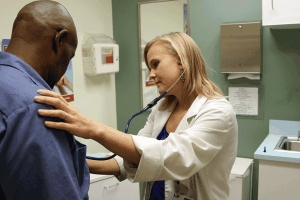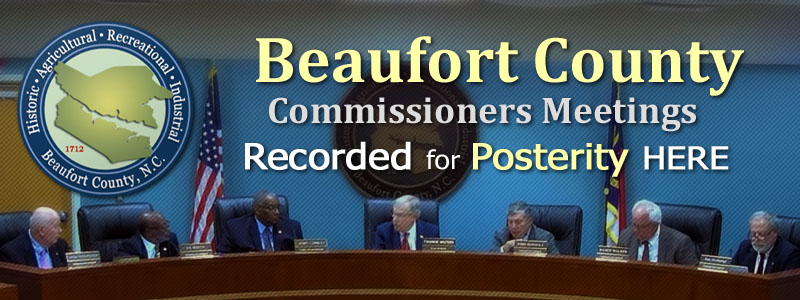Publisher's note: The author of this post is Dan Way, who is an associate editor for the Carolina Journal, John Hood Publisher.
Officials are unsure whether patient rolls will rise or fall
Lisanna Gonzalez, a family nurse practitioner who has been providing health care for patients at Piedmont Health Services' community health center in Carrboro for the past year, conducts a physical examination on a patient at the clinic.
RALEIGH - Concern is rising among community health centers that serve nearly a half million patients in North Carolina yearly - most of them uninsured - that Obamacare may drain away their patients and doctors. Meantime, officials say, patients are antsy about how the law will affect them.
The Affordable Care Act, as Obamacare is officially known, mandates that everyone who is not covered by an employer-provided health plan purchase individual insurance by Jan. 1 or pay a fine. Enrollment is set to begin in state and federal health care exchanges Oct. 1, and includes tax-credit subsidies to participants who meet income eligibility standards.
Patients are "very curious, and very nervous, too," about Obamacare's effects on their health care, said Eugene Chalwe, director of Piedmont Health Services' community health center in Carrboro, which serves between 2,400 and 3,600 patients a month.
Currently, 52 percent of community health center patients in North Carolina are uninsured, compared with 36 percent nationally. Of the insured population, 22 percent have Medicaid, about 12 percent Medicare, and about 14 percent private insurance.
Despite the Obamacare mandates, some individuals might opt out of purchasing insurance and pay a tax penalty, said Rebecca Whitaker, spokeswoman for the North Carolina Community Care Association. In addition, there are 355,000 people who earn less than 100 percent of the federal poverty level who are ineligible for subsidies on the exchange and unlikely to be able to afford insurance.
"For folks between 100 and 138 percent of poverty, if they're qualified for a subsidy to purchase private insurance and some cost-sharing reductions, it may still be $100 a month for a premium," and they may remain uninsured because of the cost, Whitaker said.
"Even folks who could afford it could decide - because it's the young 'invincible' population - not to purchase health insurance, knowing they could go to a health center and access care on the sliding-fee scale," Whitaker said.
She said fundamental uncertainties about Obamacare are ratcheting up anxiety among the 34 federally qualified health centers in the state that operate about 180 different clinical sites in 62 counties, and among medical professionals who staff them.
If Blue Cross and Blue Shield of North Carolina and Coventry Health Care of the Carolinas, the only applicants on North Carolina's federal exchange, siphon community health center patients into their plan networks, the centers would struggle to pay for medical care for the uninsured, Whitaker said.
"Concern about maintaining and growing your patient population is even more compounded by what's on the horizon for health center funding in the future," Whitaker said. Federal allocations to care for the uninsured are scheduled to drop "pretty dramatically" in 2016.
"So certainly if the future of the health center is threatened and the financial stability is threatened because their payer mix of federal support and community support can no longer sustain operations, I think that would worry anybody," Whitaker said. "I think it's a pretty significant concern."
Community heath centers serve 466,000 individual patients during 1,447,499 visits annually, she said. The centers are required by law to care for anyone, regardless of ability to pay.
Overall, 94 percent of patients in community health centers across North Carolina have incomes less than 200 percent of the poverty level and are eligible for participation in the sliding-fee scale, she said.
"So we're actually waiting for some guidance from the federal government ... how to apply sliding fees to those individuals who may decide not to purchase insurance," Whitaker said.
At Piedmont Health Services, 67 percent of the patients are uninsured and pay the lowest fee on the sliding scale.
But Brian Toomey, Piedmont Health CEO, does not share the same foreboding as many of his colleagues.
Indeed, he is planning to add a community health center in Burlington and another in Chapel Hill in the near future to complement the seven Piedmont Health centers in Carrboro, Prospect Hill, Burlington, Snow Camp, Union Ridge, Siler City, and Moncure. The Piedmont system serves more than 40,000 patients at 110,000 visits annually.
"We believe that once people see us, the vast, vast majority ... are very pleasantly surprised," Toomey said.
"We think we're going to be adding patient loads," he said.
"That was the experience that health centers saw in Massachusetts," Toomey said. Then-Gov. Mitt Romney implemented state-based health care reforms in 2006 that many observers say were the basis for Obamacare.
"We think that's going to be the experience that happens here as well. We think there are many people who got to know us because of our small-business plan, got to see us in a different light than they would have normally, expected us to be, and found out that we're a really good value for the dollar," Toomey said.
The small-business plan partners with chambers of commerce in Piedmont Health's service area, providing low-cost health care and a medical home to employees and their families who are in chamber member businesses that are underinsured or uninsured.
"History shows that some people will leave us, because for the first time in their life they [can choose] where they can get their health care, and I'm glad they exercise that right," Toomey said. "Part of [the uncertainty] is because this is all new," he said.
Piedmont Health receives 12 percent of its $39 million annual budget from the federal grants that community health centers receive for uncompensated care. Nationally, the grant average is 33 percent.
Piedmont Health already incurs expenses for uncompensated care at 135 percent of its grant amount, and in 2016 the federal grant will be reduced by 40 percent.
"Obviously that's a very large number, but the design of what was supposed to happen and is supposed to happen is that that would be offset by the number of insured people that we will now be taking care of," Toomey said.
Piedmont received a $340,000 federal outreach grant through which three case workers and a manger work to enroll patients in the Obamacare exchange.
Twila Brase, president of the St. Paul, Minn.-based Citizens' Council for Health Freedom, is among those who believe community health centers nationwide are participating in their own demise by assisting uninsured patients to enroll in Obamacare exchanges.
"I could see the health plans depriving [health centers] of patients. So all the people that they have now they go into the exchange and get, quote, covered, but they can't find their way into a doctor's office anywhere because of the long lines," Brase said.
"Meanwhile, the health plans [won't] put community health centers into the limited network and that means [patients will not go] to the community health centers, which [would cut] patients off from that as an option," Brase said.
She is not convinced community health centers are necessary.
"It would be far better to take all of that taxpayer money, and let people keep it in their pockets, and build an entire charitable care system" that would be less expensive and provide more medical services than the community health center model, Brase said.
Toomey believes community health centers will remain vital operations, given their experience in providing medical services in low-income communities.























